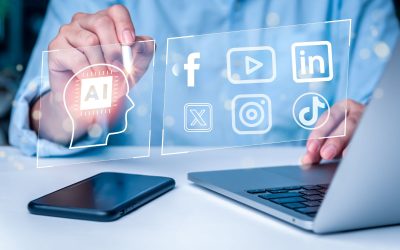Table of Contents

In today’s digital landscape, web design is evolving rapidly, and artificial intelligence (AI) is at the forefront of this transformation. The integration of AI and web design is revolutionizing how users interact with websites, making their experiences more personalized, efficient, and engaging. This blog post explores how AI and web design can be seamlessly incorporated to enhance user experience through chatbots, personalized content recommendations, and advanced data analytics.
Understanding AI in Web Design
AI and web design refer to the use of machine learning algorithms and other AI technologies to create websites that are more interactive, responsive, and user-friendly. By leveraging AI and web design, web designers can develop websites that adapt to user preferences and behaviors, resulting in a more intuitive and personalized browsing experience.
Chatbots: The New Face of Customer Interaction

What Are Chatbots?
Chatbots are AI-powered virtual assistants that interact with users in real-time, answering questions, providing support, and even guiding users through various processes on a website. They are designed to simulate human conversation and can be integrated into AI and web design to enhance user engagement.
How Chatbots Improve User Experience
- 24/7 Availability: Unlike human support agents, chatbots are available around the clock, providing users with instant assistance regardless of time zones or business hours. This integration of AI and web design ensures that users receive timely help whenever they need it.
- Personalized Interactions: By analyzing user data, chatbots can offer personalized responses, making users feel understood and valued. For instance, a user browsing an online store can receive product recommendations based on their past purchases or browsing history, showcasing the power of AI and web design in creating tailored experiences.
- Efficiency and Convenience: Chatbots streamline the user experience by providing quick answers to common queries and guiding users through complex processes, reducing the need for users to search for information manually.
Learn more about how chatbots are transforming customer service.
Personalized Content Recommendations: Tailoring the User Journey

The Power of Personalization
Personalization is key to enhancing user experience on websites. AI and web design enable web designers to create personalized experiences by analyzing user data and behavior to recommend content that aligns with the user’s interests and preferences.
Implementing Personalized Content
- Dynamic Content Display: AI algorithms can analyze a user’s past behavior on a site and display content that matches their interests. For example, a news website might show more articles about technology to a user who frequently reads tech-related content.
- Product Recommendations: E-commerce websites can leverage AI and web design to suggest products based on a user’s browsing history, previous purchases, or items in their shopping cart, significantly increasing the chances of conversion.
- Customized User Interfaces: AI and web design can also personalize the visual elements of a website, such as colors, fonts, and layouts, based on the user’s preferences, making the site more appealing and easier to navigate.
Advanced-Data Analytics: Understanding User Behavior

Leveraging AI for Data Analytics
AI and web design offer advanced data analytics that provides web designers with deep insights into user behavior. By analyzing vast amounts of data, AI can identify patterns and trends that might not be apparent through traditional analytics methods. This information can be used to optimize website design and functionality, ultimately improving the user experience.
Key Benefits of AI-Driven Analytics
- Behavioral Insights: AI and web design can analyze user interactions on a website to understand what users are looking for, how they navigate the site, and what factors influence their decisions. This information helps designers create a more intuitive and user-friendly website.
- Predictive Analytics: By analyzing past user behavior, AI and web design can predict future actions, allowing websites to proactively suggest content or features that align with the user’s needs.
- Continuous Improvement: AI and web design involve analytics that continuously monitor user interactions, providing real-time feedback that designers can use to make ongoing improvements to the website.
Integrating AI into Your Web Design Strategy
Integrating AI and web design is not just about adding new features; it’s about creating a seamless, engaging, and personalized experience for users. Here are some steps to consider when incorporating AI and web design into your strategy:
- Identify User Needs: Start by understanding your audience and identifying their needs and preferences. This will help you determine which AI and web design technologies to implement.
- Choose the Right AI Tools: Depending on your website’s goals, you may choose to implement chatbots, personalized content algorithms, or data analytics tools. Ensure that these AI and web design tools align with your overall design strategy and enhance the user experience.
- Monitor and Optimize: AI and web design tools require continuous monitoring and optimization to ensure they are delivering the desired results. Use analytics to track performance and make adjustments as needed.
Conclusion: The Future of Web Design is AI-Driven
The integration of AI and web design is not just a trend; it’s a fundamental shift in how websites are created and experienced. By leveraging AI and web design technologies such as chatbots, personalized content recommendations, and advanced data analytics, web designers can create more engaging, intuitive, and personalized experiences for users. As AI continues to evolve, its impact on AI and web design will only grow, offering exciting opportunities for enhancing user experience.
For more insights on integrating AI and web design, check out Pressific, a leader in creating innovative and user-centric web experiences.
By staying at the forefront of AI advancements, web designers can ensure their sites not only meet but exceed user expectations, setting a new standard for what’s possible on the web.
Also read,






